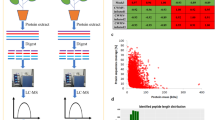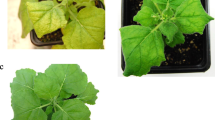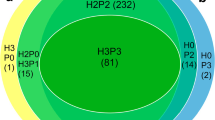Abstract
Tymovirus is a genus of plant pathogenic viruses that infects several dicotyledonous plants worldwide, causing serious diseases in economically important crops. The known cytopathic effect on the host cell organelles involves chloroplast membrane deformation and the induction of vesicles in its periphery. These vesicles are known to be the location where tymoviral genomic RNA replication occurs. Tomato blistering mosaic virus (ToBMV) is a tymovirus recently identified in tomato plants in Brazil, which is able to infect several other plants, including tobacco. In this work, we investigated the chloroplast proteomic profile of ToBMV-infected N. benthamiana using bidimensional electrophoresis (2-DE) and mass spectrometry, aiming to study the virus-host interaction related to the virus replication and infection. A total of approximately 200 spots were resolved, out of which 36 were differentially abundant. Differential spots were identified by mass spectrometry including photosynthesis-related and defense proteins. We identified proteins that may be targets of a direct interaction with viral proteins, such as ATP synthase β subunit, RNA polymerase beta-subunit, 50S ribosomal protein L6 and Trigger factor-like protein. The identification of these candidate proteins gives support for future protein–protein interaction studies to confirm their roles in virus replication and disease development.


Similar content being viewed by others
References
Hull R (2002) CHAPTER 1 - introduction. In: Matthews’ plant virology, 4th edn. Academic Press, London, pp 1–12 https://doi.org/10.1016/B978-012361160-4/50052-9
Ribeiro S, Kitajima E, Oliveira R, Koenig R (1996) A strain of eggplant mosaic virus isolated from naturally infected tobacco plants in Brazil. Plant Dis 80(4):446–449
Alexandre MAV, Duarte LML, Rivas EB, Chagas CM, Barradas MM, Koenig R (2000) Petunia vein banding virus: characterization of a new tymovirus from petunia × hybrida. Plant Dis 84(7):739–742. https://doi.org/10.1094/pdis.2000.84.7.739
Crestani O, Kitajima E, Lin M, Marinho V (1986) Passion fruit yellow mosaic virus, a new tymovirus found in Brazil. Phytopathology 76(9):951–955
Nicolini C, Pio-Ribeiro G, Andrade GP, Melo FL, Oliveira VC, Guimarães FC, Resende RO, Kitajima EW, Rezende JAM, Nagata T (2012) A distinct tymovirus infecting cassia hoffmannseggii in Brazil. Virus Genes 45(1):190–194. https://doi.org/10.1007/s11262-012-0750-9
Nicolini C, Inoue-Nagata AK, Nagata T (2015) Complete genome sequence of a proposed new tymovirus, tomato blistering mosaic virus. Arch Virol 160(2):609–612. https://doi.org/10.1007/s00705-014-2289-7
de Oliveira VC, Nagata T, Guimarães FC, Ferreira FA, Kitajima EW, Nicolini C, de Oliveira Resende R, Inoue-Nagata AK (2013) Characterization of a novel tymovirus on tomato plants in Brazil. Virus Genes 46(1):190–194. https://doi.org/10.1007/s11262-012-0830-x
Blawid R, Hayashi EAI, Rezende JAM, Kitajima EW, Nagata T (2016) A highly divergent isolate of tomato blistering mosaic virus from Solanum violaefolium. Virus Genes 52(2):294–298. https://doi.org/10.1007/s11262-016-1288-z
Melo FL, Fernandes JEA, Ribeiro BM, Ribeiro SG (2014) Complete genome sequence of a tobacco-infecting, tomato-blistering mosaic virus. Genome Announcements 2(4):e00701–e00714.
Ferrand L, Nome C, Orílio AF, García ML, Nagata T, Ronco LB, Dal Bó E (2015) First report of tomato blistering mosaic virus infecting tomato in Argentina. Plant Dis 100(5):1026. https://doi.org/10.1094/pdis-07-15-0782-pdn
Verchot J (2011) Wrapping membranes around plant virus infection. Curr Opin Virol 1(5):388–395. https://doi.org/10.1016/j.coviro.2011.09.009
Di Carli M, Benvenuto E, Donini M (2012) Recent insights into plant–virus interactions through proteomic analysis. J Prot Res 11(10):4765–4780. https://doi.org/10.1021/pr300494e
Peltier J-B, Friso G, Kalume DE, Roepstorff P, Nilsson F, Adamska I, van Wijk KJ (2000) Proteomics of the chloroplast: systematic identification and targeting analysis of lumenal and peripheral thylakoid proteins. Plant Cell 12(3):319–342
Peltier J-B, Emanuelsson O, Kalume DE, Ytterberg J, Friso G, Rudella A, Liberles DA, Söderberg L, Roepstorff P, von Heijne G, van Wijk KJ (2002) Central functions of the lumenal and peripheral thylakoid proteome of Arabidopsis determined by experimentation and genome-wide prediction. Plant Cell 14(1):211–236. https://doi.org/10.1105/tpc.010304
Pineda M, Sajnani C, Barón M (2010) Changes induced by the Pepper mild mottle tobamovirus on the chloroplast proteome of Nicotiana benthamiana. Photosynth Res 103(1):31. https://doi.org/10.1007/s11120-009-9499-y
Zhao J, Zhang X, Hong Y, Liu Y (2016) Chloroplast in plant-virus interaction. Front Microbiol 7:1565. https://doi.org/10.3389/fmicb.2016.01565
Brizard JP, Carapito C, Delalande F, Van Dorsselaer A, Brugidou C (2006) Proteome analysis of plant-virus interactome: comprehensive data for virus multiplication inside their hosts. Mol Cell Proteomics 5(12):2279–2297
Boatwright JL, Pajerowska-Mukhtar K (2013) Salicylic acid: an old hormone up to new tricks. Mol Plant Pathol 14(6):623–634. https://doi.org/10.1111/mpp.12035
Wasternack C, Hause B (2013) Jasmonates: biosynthesis, perception, signal transduction and action in plant stress response, growth and development. An update to the 2007 review in annals of botany. Ann Bot 111(6):1021–1058. https://doi.org/10.1093/aob/mct067
Alazem M, Lin N-S (2015) Roles of plant hormones in the regulation of host–virus interactions. Mol Plant Pathol 16(5):529–540. https://doi.org/10.1111/mpp.12204
Kubis SE, Lilley KS, Jarvis P (2008) Isolation and preparation of chloroplasts from Arabidopsis thaliana plants. In: Posch A (ed) 2D PAGE: sample preparation and fractionation. Humana Press, Totowa, pp 171–186 https://doi.org/10.1007/978-1-60327-210-0_16
Carmo LST, Resende RO, Silva LP, Ribeiro SG, Mehta A (2013) Identification of host proteins modulated by the virulence factor AC2 of Tomato chlorotic mottle virus in Nicotiana benthamiana. Proteomics 13(12–13):1947–1960. https://doi.org/10.1002/pmic.201200547
Seo S, Okamoto M, Iwai T, Iwano M, Fukui K, Isogai A, Nakajima N, Ohashi Y (2000) Reduced levels of chloroplast FtsH protein in tobacco mosaic virus–infected tobacco leaves accelerate the hypersensitive reaction. Plant Cell 12(6):917–932
Bhat S, Folimonova SY, Cole AB, Ballard KD, Lei Z, Watson BS, Sumner LW, Nelson RS (2013) Influence of host chloroplast proteins on tobacco mosaic virus accumulation and intercellular movement. Plant Physiol 161(1):134–147. https://doi.org/10.1104/pp.112.207860
Mochizuki T, Ogata Y, Hirata Y, Ohki ST (2014) Quantitative transcriptional changes associated with chlorosis severity in mosaic leaves of tobacco plants infected with Cucumber mosaic virus. Mol Plant Pathol 15(3):242–254
Kundu S, Chakraborty D, Kundu A, Pal A (2013) Proteomics approach combined with biochemical attributes to elucidate compatible and incompatible plant-virus interactions between Vigna mungo and Mungbean yellow mosaic India Virus. Proteome Sci 11:15. https://doi.org/10.1186/1477-5956-11-15
Wu L, Wang S, Chen X, Wang X, Zu X, Chen Y (2013) Proteomic and phytohormone analysis of the response of maize (Zea mays L.) seedlings to sugarcane mosaic virus. PLoS ONE 8(7):e70295. https://doi.org/10.1371/journal.pone.0070295
Pan X, Zhu B, Luo Y, Fu D (2013) Unraveling the protein network of tomato fruit in response to necrotrophic phytopathogenic Rhizopus nigricans. PLoS ONE 8(9):e73034. https://doi.org/10.1371/journal.pone.0073034
Ji X, Gai Y, Zheng C, Mu Z (2009) Comparative proteomic analysis provides new insights into mulberry dwarf responses in mulberry (Morus alba L.). Proteomics 9(23):5328–5339. https://doi.org/10.1002/pmic.200900012
Vass I, Cser K, Cheregi O (2007) Molecular mechanisms of light stress of photosynthesis. Ann NY Acad Sci 1113:114–122. https://doi.org/10.1196/annals.1391.017
Houtz RL, Portis AR (2003) The life of ribulose 1,5-bisphosphate carboxylase/oxygenase–posttranslational facts and mysteries. Arch Biochem Biophys 414(2):150–158
Ellis RJ (2013) Assembly chaperones: a perspective. Philos Trans R Soc Lond B Biol Sci 368(1617):20110398. https://doi.org/10.1098/rstb.2011.0398
Gorovits R, Moshe A, Ghanim M, Czosnek H (2013) Recruitment of the host plant heat shock protein 70 by tomato yellow leaf curl virus coat protein is required for virus infection. PLoS ONE 8(7):e70280. https://doi.org/10.1371/journal.pone.0070280
Ahlquist P (2002) RNA-dependent RNA polymerases, viruses, and RNA silencing. Science 296(5571):1270–1273. https://doi.org/10.1126/science.1069132
Pérez-Bueno ML, Rahoutei J, Sajnani C, García-Luque I, Barón M (2004) Proteomic analysis of the oxygen-evolving complex of photosystem II under biotec stress: studies on Nicotiana benthamiana infected with tobamoviruses. Proteomics 4(2):418–425. https://doi.org/10.1002/pmic.200300655
Fraser RS (1969) Effects of two TMV strains on the synthesis and stability of chloroplast ribosomal RNA in tobacco leaves. Mol Gen Genet 106(1):73–79
Walsh D, Mohr I (2011) Viral subversion of the host protein synthesis machinery. Nat Rev Microbiol 9(12):860–875. https://doi.org/10.1038/nrmicro2655
Acknowledgements
This work was sponsored by Embrapa, UnB, CAPES and CNPq.
Author information
Authors and Affiliations
Corresponding author
Ethics declarations
Conflict of interest
Authors have no conflict of interest to declare.
Rights and permissions
About this article
Cite this article
Megias, E., do Carmo, L.S.T., Nicolini, C. et al. Chloroplast Proteome of Nicotiana benthamiana Infected by Tomato Blistering Mosaic Virus. Protein J 37, 290–299 (2018). https://doi.org/10.1007/s10930-018-9775-9
Published:
Issue Date:
DOI: https://doi.org/10.1007/s10930-018-9775-9




